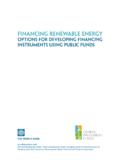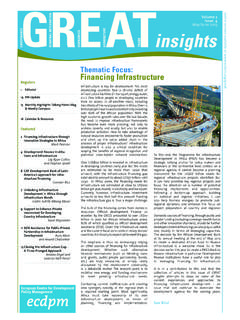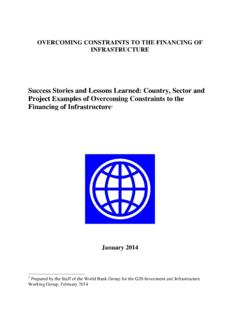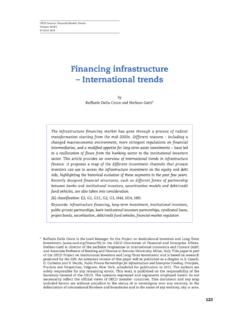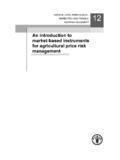Transcription of THE INFRASTRUCTURE INVESTMENT NEEDS AND …
1 Port Investments Study 20181 THE INFRASTRUCTUREINVESTMENT NEEDSAND financing CHALLENGE OF EUROPEAN PORTSESPOR eport prepared for the European Seaports Organisation (ESPO)Prepared by Peter de Langen, Mateu Turr , Martina Fontanet and Jordi Caball MESSAGE FROM THE CHAIR IESPO RECOMMENDATIONS IISTUDY: THE INFRASTRUCTURE INVESTMENT NEEDS AND financing CHALLENGE OF EUROPEAN PORTS Introduction 3 INTRODUCTORY CHAPTER1. The role of ports in theeu economy and the EU TEN-Tpolicy for ports 5 ANALYSIS OF INVESTMENTS IN PORTS2. Characteristics of investments in port INFRASTRUCTURE 113. The challenge of financing port INFRASTRUCTURE investments 214. INVESTMENT NEEDS and INVESTMENT priorities of European ports 31 ASSESSMENT OF PAST & CURRENT EU POLICIES ON PORT INVESTMENTS5. EU port policies and instruments for financing investments in port INFRASTRUCTURE 456.
2 The EU policy framework (2014 2020) and its results for ports until 2017 53 ASSESSMENT OF EVALUATION AND ADMINISTRATIVE PROCESSES7. The evaluation processes for EU financial instruments 67 CONCLUDING RECOMMENDATIONS 8. Summary: Towards effective mechanismsto support INVESTMENT priorities in ports 75 THE AUTHORS 81 REFERENCES 82 APPENDIX 1: EU CORE PORTS PER CORRIDOR 83 APPENDIX 2: THE SPLIT BETWEEN GENERAL AND COHESION CALLS 84 GLOSSARY 85 Cover picture: painting from the series The Colours of ESPO, reflections on upcoming harbourscapes by Sasja Hagens. Port Investments Study 2018 IMESSAGE FROM THE CHAIRThe development of the Single European Market required the elimination of a range of barriers to trade. Nowhere is this more evident than in Europe s seaports where the work to create a level playing pitch has been a project of decades.
3 In recent years, however, there has been a range of inter-related EU policy initiatives which have largely created the level playing pitch in the port sector. As a result, seaports are now in the position to fully realise their potential and maximise their contribution to the prosperity of people and communities throughout the to this change has been the increased focus on ports as commercial entities with increased financial autonomy in most cases. However, this new perspective highlights a conundrum at the heart of port development plans. In many cases, the main benefits of port projects accrue to the wider community and economy rather than to the port authority itself. This is particularly true when ports invest in basic INFRASTRUCTURE to provide capacity for future that, the requirement for ports to invest in basic INFRASTRUCTURE has been joined by a range of INVESTMENT requirements as a result of wider societal imperatives particularly in the areas of environmental policy and energy challenge ports everywhere face now, is to implement projects which often are financially unattractive to the port authority and even less attractive to external investors but which are essential for wider societal and economic ports are financially strong enough to finance such projects and accept the low financial returns.
4 Other ports are challenged to implement projects which are essential but are entirely beyond their Connecting Europe Facility (CEF) is the essential means to resolve this policy recognises ports as engines for growth. Europe s ports have the projects ready to meet TEN-T objectives. CEF is the CEF ll is being prepared, the experience and expertise of Europe s ports has been harnessed in this study report by ESPO to provide Europe s institutions with an informed viewpoint on the NEEDS of ports and on how ports can contribute to the achievement of TEN-T and other EU recognises that there are many demands on the EU budget at a time when the size of this budget is challenged by Brexit. But there are important choices to be made in how scarce resources are allocated. ESPO contends that INVESTMENT in Europe s seaports is essential if critical policy objectives are to be met in a wide range of EU policy areas.
5 If Europe s seaports cannot make the investments that are needed, then key policy objectives in the areas of transport, energy and environment will be key findings are presented in this report, which go beyond a simplistic request by ports for more funds, to inform the debate and discussion of the size and allocation of the budget for the second Connecting Europe O ReillyPort Investments Study 2018 RECOMMENDATIONS OF THE EUROPEAN SEA PORTS ORGANISATIONIn preparation of the Connecting Europe Facility II (CEF II) budget proposal 1 Policy recommendationsThe European Sea Ports Organisation (ESPO) welcomes the opportunity to participate in the preparatory process of the future Connecting Europe Facility (CEF II). In order to draw up well-reasoned recommendations, ESPO commissioned a study on the INFRASTRUCTURE INVESTMENT NEEDS and financing challenges of ports.
6 ESPO acknowledges that CEF has proved to be an efficient financial instrument, which is based on a sound strategic framework (TEN-T) and has provided important support to a series of valuable projects in European seaports. However, the size of the current CEF is a limited means to complete the TEN-T network, as demonstrated by the substantial oversubscription of the various calls. Based on this acknowledgement and the analysis carried out in the following study, the European Sea Ports Organisation puts forward the following considerations:Ports are vital for the EU economySeaports have evolved from the classic role of being predominantly responsible for the reception of ships (their loading and unloading and the storage and transport of goods) to a more comprehensive entity of functional and spatial clusters of activities which are directly or indirectly linked to maritime transportation.
7 The passenger dimension has gained substantial importance, with ports playing a key role for the provision of the relevant facilities and for enabling the passengers connectivity. Moreover, many ports have developed into strategic nodes for energy generation, trade, storage and distribution, and increasingly important clusters of industry and blue economy. Ports have been constituting the main link from maritime transport to any destination in the hinterland. On top of that, some ports have been identified as critical INFRASTRUCTURE due to their strategic 2013 TEN-T policy acknowledges the ports crucial role as primary nodes of the network and as starting points of the TEN-T corridors. Despite the recognition of the significant role of ports and their very diverse responsibilities, port projects initiated by port managing bodies only succeeded to attract 4% of the CEF transport funding during the period 2014 2017 2.
8 1. Legal Notice: The content of these recommendations is based on the findings of the study The INFRASTRUCTURE INVESTMENT NEEDS and financing challenge of European ports , but solely reflects the views of the European Seaports It is important to bear in mind that other projects benefitted ports which are not initiated by the port authorities, or where the port authority is not the main applicant. IIPort Investments Study 2018 Efficient, sustainable and well-connected ports need investmentsAccording to the estimation of the European Commission, the investments from 2016 until 2030 needed for realising the core network in its totality amount to about 750 billion study reveals that European seaports (EU-27) currently face substantial INVESTMENT NEEDS of around 48 billion (5 billion annually) for the period 2018 2027.
9 As these INVESTMENT NEEDS are mostly driven by dynamic and continuous trends, such as the rapid development of the logistics industry, the port related industry and environmental requirements, port investments will remain crucial in the stated in the Valetta Declaration, well-connected and modern ports play a key role to preserve and attract new industries and logistic activities, to link up the different regions within the internal market of the European Union and support the greening of transport. This role requires ports to make substantial investments, in order to maintain and enhance existing INFRASTRUCTURE , to create new transport links and to improve the environmental sustainability of port of INVESTMENT driversPorts are facing several challenges that have a major impact on the requirements for INFRASTRUCTURE investments: new trends in the maritime industry (increasing vessel sizes, increasing market power through alliances), the decarbonisation agenda, building resilience to climate change and the overall greening of vessels, digitalization and automation, increased security challenges, growing urbanisation and increasing pressure from expanding cities, as well as Brexit.
10 There are consequently many more requirements for developing new and adapting existing port INFRASTRUCTURE than simply increasing a large extent, these INVESTMENT NEEDS are triggered by external drivers (for example the need for LNG INFRASTRUCTURE to facilitate the greening of vessels). The future CEF call priorities and the specific blend of instruments should reflect the diversity of the INVESTMENT drivers, in order to better account for the various INVESTMENT diverse port INVESTMENT NEEDS Even though basic INFRASTRUCTURE remains the largest INVESTMENT category, port INVESTMENT NEEDS are very diverse, as displayed by the graph below. The analysed projects feature a balanced mix of project stages, with projects in (partial) execution, others ready for execution, as well as projects in the study and idea European Commission, Delivering TEN-T, Facts & Figures September 2017.

